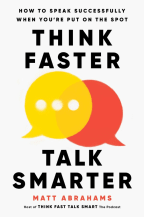'What do you think?'
If you're in an office meeting, lecture hall or job interview, these can be four of the most terrifying words in the English language.
It's untrue that we're either born with or without the gift of gab, says communication expert Matt Abrahams.
We can all do specific things to help ourselves 'speak up without freaking out', he tells Jesse Mulligan.

Matt Abrahams - a lecturer in strategic communication at Stanford University Photo: Nancy Rothstein

Photo: supplied
About nine years ago, the deans of Stanford Business School, where Abrahams is a lecturer, asked him to create some content to help students speak up.
After a "deep dive" into research in psychology, anthropology, neuroscience, acting and improvisation, he developed a methodology that every new Stanford MBA candidate now has the opportunity to study.
Although this stemmed from "a very specific academic need", the ideas contained have helped people develop confidence in all kinds of situations.
Matt Abrahams hosts the award-winning podcast Think Fast, Talk Smart and is the author of Think Faster, Talk Smarter.
There is no 'right' way to speak
Anxiety is inherent in all human communication, Abrahams says, and it wouldn't be helpful to overcome it even if we could.
"It actually gives us energy helps us focus, tells us what we're doing is important, but we want to manage it so it doesn't manage us."
Keep in mind that you are not the best judge of your own "communicative performance", he says, and also have much more insight than anyone watching or listening about what's going on in your body and what you'd planned to say.
To "free up cognitive resources" while speaking, he recommends people maximise mediocrity and focus on connection, not perfection.
"If part of your brain is focusing on judging and evaluating everything you say, you only have part of it able to focus on what you're actually saying. It's a cognitive bandwidth issue. So we need to dial that down.
"I am certainly not saying that we just want to be mediocre. But when we take the pressure off to be perfect, then we can do really great things."
To put less pressure on your speaking, try and view it as foremost an opportunity for building connection, even in a challenging situation.
"When you see things as an opportunity, even if it's a really threatening and hard question, it changes not just the quality of the answers but the quality of our experience in answering those questions."
Follow-up questions that you're not able to anticipate are also opportunities to work on being - and demonstrating - that you're present, open and collaborative.
"There are better ways or worse ways [to speak] but no one right way. And that pressure we put on ourselves to get it right, really really hampers us ... You appear more competent than you feel."
'Chunk up' your message
To effectively communicate information, Abrahams says it's helpful to deliver it in "chunks" that are each part of a logical structure.
"Many of us when we're put on the spot, we take our audiences on the journey of our discovery of what we're saying. And we just list a whole bunch of information. And all of us have suffered through people who listen too much and ramble.
The 'problem solution benefit' structure - "Here's an issue, challenge or problem. Here's how we're solving it. And here's the benefit." - is one example of how information can be "chunked" together in a logical fashion.
"Each one of those concepts] is a logical chunk that connects to the next. Beyond being logical, our brains like to learn from structure. It also helps us remember … we learn what we hear first and last more than anything else. And we remember it more
"When you 'chunk' something you're creating many more beginnings and endings. So you're actually helping your audience remember it, not only by putting in a logical structure but by giving them more beginnings and endings. Those of us who communicate effectively in the moment do a really good job of structuring information."
Tell good stories
The things that are most memorable to us are usually packaged up as a story, Abrahams says.
"Our brains are wired for story. Humans have evolved to pay attention to things and remember things that are told in a story format …. So any time you can put your information into a structure that has logical flow [that] helps.
"My favourite structure in the whole world is three simple questions - What? So what? Now what? ... What is your information, your idea, your product, your service, your belief? The 'So what?' is why is it important to the person you're talking to. And the 'now what' is what comes next.
"Just using those three simple questions is a great example of a story or narrative that you tell in response to feedback, in response to questions, in response to small talk. It can be used in lots of ways in lots of places."
In a job interview, Abrahams says it's helpful to convert the key themes that you want to get across into stories.
"[For example] Maybe I'm really good at problem-solving or I'm very reliable and detail-oriented. Those are themes. And with each theme, you stockpile specific, concrete examples, stories you can tell, data you can give, third-party testimonials, like if you won an award, and you stockpile them.
"In the moment when somebody asks you a question you are simply assembling what you've previously thought ... 'Oh, this is a question about this theme. I know I have these few examples or stories I can tell'. And put them together into an answer that's useful.
"The goal of interviewing is to tell stories that your interviewer can then turn around and tell others who have to help make the decision to hire you.
"Often the person you interview with is not the hiring person, they have to go talk to other people. So you have to equip them with detailed information that they can share about you."
Small talk - surviving and thriving
Good things and big things happen during so-called small talk, Abrahams says.
"We can learn about ourselves and others, we can form new friendships and connections. Small talk can be a really big help to us."
"In small talk, the goal is to be interested, not interesting," is a great piece of advice dating coach and academic Rachel Greenwald gave on Abrahams' podcast Think Fast, Talk Smart.
"We need to lead with curiosity and questions. And when we do that, it goes more smoothly."
When it comes to small talk, the biggest challenges people report to Abrahams are getting into it and getting out of it.
Bringing up something happening in the moment or any other shared experience is a good way in, he says.
As a method of getting out of small talk, Abrahams recommends Rachel Greenwald's White Flag Approach.
How AI can help us speak
Generative artificial intelligence tools such as ChatGPT can be helpful with preparing for spontaneous speaking, Abrahams says.
"Say I'm interviewing for a job at this company, [I could ask it to] generate five questions that I might get asked. So it's a good tool to help bring up questions.
"It's also a good tool to help you be more concise. So if you write something, you can plug it in and say 'Say this in 100 fewer words than I typed in' and then look at it and think about what's it doing to prioritise so that trains your brain on how to prioritise.
"In terms of communication in general. I am still a little hesitant about certain things [relating to AI]. But I am curious and staying tuned to see how generative AI plays out in the next few months and years."

